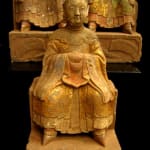Set of 3 Ming Dynasty Painted and Gilded Sandstone Seated Female Figures, 1368 CE - 1644 CE
Sandstone
9.84 x 20.87
DL.1009
Upon leading a victorious rebellion against the foreign Mongul rulers of the Yuan Dynasty, a peasant named Zhu Yuanzhang seized control of China and founded the Ming Dynasty in 1368....
Upon leading a victorious rebellion against the foreign Mongul rulers of the Yuan Dynasty, a peasant named Zhu Yuanzhang seized control of China and founded the Ming Dynasty in 1368. Culturally, the greatest innovation of the Ming Dynasty was the introduction of the novel. Developed from the folk tales of traditional storytellers, these works were transcribed in the everyday vernacular language of the people. Advances in printmaking and the increasing population of urban dwellers largely contributed to the success of these books. Architecturally, the most famous monument of the Ming Dynasty is surely the complex of temples and palaces known as the Forbidden City that was constructed in Beijing after the third ruler of the Ming Dynasty, Emperor Yongle, moved the capital there. Today, the Forbidden Palace remains one of the hallmarks of traditional Chinese architecture and is one of the most popular tourist destinations in the vast nation.
This stunning set of three seated female figures dates from this exciting period of artistic achievement. Each figure is seated on a bench, which is raised up on a high plinth, decorated with low relief carvings of a pair of scissors and a comb. The women, dressed in elaborate robes with wide sleeves, hold small dishes in their hands which may represent offering bowls of some kind. Their hair is arranged in a tight bun which crowns their head. Considerable traces of the original polychromy survive including blues, greens, reds and a golden yellow. The faces have been painted white to stand out against the vibrant rainbow of colours which adorned their costumes. Although each woman adopts an almost identical pose, their facial features have been carefully differentiated. This spectacular set of sculptures gives a vivid impression of the artistic excellence achieved during the Ming era.
This stunning set of three seated female figures dates from this exciting period of artistic achievement. Each figure is seated on a bench, which is raised up on a high plinth, decorated with low relief carvings of a pair of scissors and a comb. The women, dressed in elaborate robes with wide sleeves, hold small dishes in their hands which may represent offering bowls of some kind. Their hair is arranged in a tight bun which crowns their head. Considerable traces of the original polychromy survive including blues, greens, reds and a golden yellow. The faces have been painted white to stand out against the vibrant rainbow of colours which adorned their costumes. Although each woman adopts an almost identical pose, their facial features have been carefully differentiated. This spectacular set of sculptures gives a vivid impression of the artistic excellence achieved during the Ming era.



